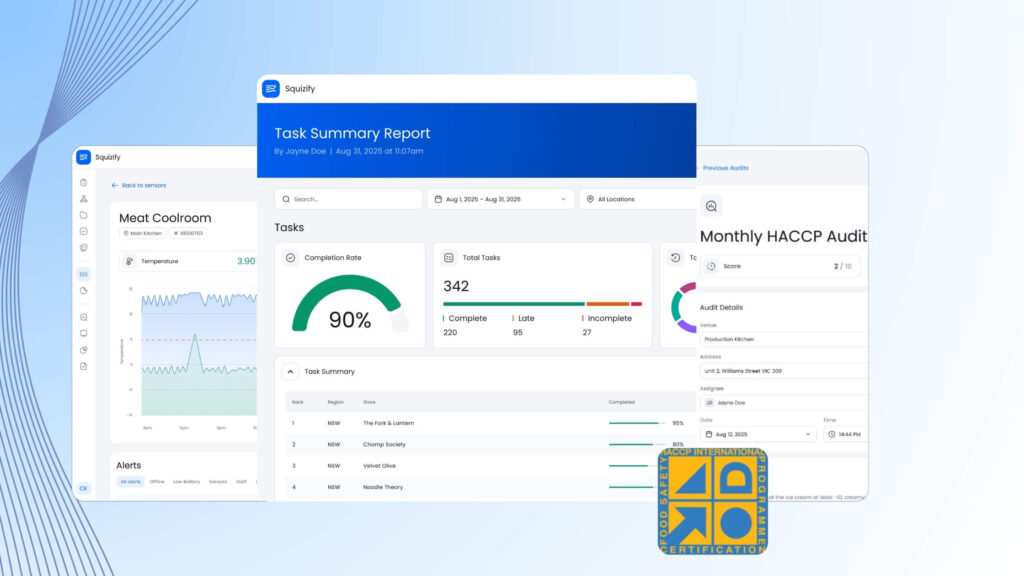Top 5 Ways a HACCP Compliance Software Can Transform Your Food Business

HACCP food safety compliance software is essential for success in the food industry, helping businesses meet strict safety standards that protect public health and reputation. Digital innovations have transformed how food businesses manage compliance, with modern software solutions offering powerful tools for:
- Real-time monitoring of critical control points
- Automated documentation and record-keeping
- Streamlined compliance processes
- Enhanced traceability capabilities
- Simplified audit preparation

What is the role of HACCP in food safety compliance?
HACCP is the global standard for food safety management, offering a systematic way to identify and control hazards. This science-based system helps food businesses prevent contamination risks through proactive monitoring and documentation.
The 7 Core HACCP Principles:
- Hazard Analysis: Identify potential biological, chemical, and physical risks
- Critical Control Points: Establish key points where controls can prevent hazards
- Critical Limits: Set measurable parameters for each control point
- Monitoring Procedures: Create systems to track critical control points
- Corrective Actions: Define steps to address deviations
- Verification: Confirm the system works effectively
- Documentation: Maintain records of all procedures and actions
Modern food safety software digitalises principles, turning manual tasks into automated workflows. Digital HACCP solutions allow real-time monitoring, instant alerts, and detailed reports, helping food businesses stay compliant, reduce errors, and streamline processes. Australian businesses use specialised HACCP software that complies with local regulations, ensuring consistent safety across production, storage, and distribution.
What are the consequences of not implementing HACCP?
Manual HACCP implementation strains food businesses with time-consuming paper systems for data entry, filing, and retrieval. Staff spend hours recording temperature checks, cleaning, and compliance manually, risking human errors like missed checks, wrong readings, and lost documents, which can lead to food safety breaches. These errors often remain unnoticed until audits, causing compliance gaps.
Common manual HACCP challenges include:
- Time-intensive documentation – Staff dedicate hours to paperwork instead of core business activities
- Inconsistent record keeping – Different team members may record data in varying formats
- Storage and accessibility issues – Physical documents can be damaged, misplaced or difficult to locate
- Delayed issue detection – Problems often surface too late without real-time monitoring
- Resource drain – Additional staff needed to manage paper-based systems
Food safety management software eliminates these inefficiencies through automated data capture, standardised recording, and instant access to critical information.
Top 5 Ways HACCP Compliance Software Can Transform Your Food Business
HACCP compliance software revolutionises food safety management with advanced technology. These digital tools address key operational challenges and enhance food safety standards industry-wide.
1. Streamlining Food Safety Compliance Processes with Automation
Automated HACCP compliance software transforms manual monitoring tasks into efficient digital processes. The software’s intelligent systems handle:
- Real-time temperature monitoring with automated alerts for immediate corrective actions
- Digital documentation of critical control points through user-friendly interfaces
- Automated scheduling of food safety checks and inspections
- Instant hazard analysis reports based on collected data
These automation features eliminate paper-based record-keeping and reduce human error in food safety protocols. Food businesses can maintain consistent monitoring of critical control points through:
- Pre-configured compliance checklists
- Automated data collection from integrated sensors
- Digital verification of corrective actions
- Instant notification systems for compliance breaches
The software’s automation standardises processes across locations, ensuring uniform food safety practices. This helps food businesses maintain consistent quality and reduces time on manual compliance.
2. Enhancing Collaboration among Stakeholders
HACCP compliance software fosters better collaboration among various stakeholders involved in food safety compliance management. With cloud-based platforms and shared access features, team members can:
- Collaborate on developing and updating HACCP plans
- Share important documents and records in real-time
- Communicate effectively through built-in messaging or comment sections
This enhanced collaboration leads to improved decision-making, faster problem-solving, and a culture of accountability within the organisation.
3. Empowering Data-Driven Decision Making
HACCP compliance software provides valuable insights through data analytics, enabling food businesses to make informed decisions. By analysing historical data and identifying trends, organisations can:
- Identify recurring hazards or non-compliance issues
- Evaluate the effectiveness of existing control measures
- Make proactive adjustments to prevent future incidents
Data-driven decision making enhances risk management strategies and promotes continuous improvement in food safety practices.
4. Improving Training and Knowledge Retention
HACCP compliance software offers training modules and resources to enhance employee knowledge and skills. Through interactive courses, videos, and assessments, team members can:
- Understand the principles of HACCP and their importance
- Familiarise themselves with specific procedures and protocols
- Stay updated on regulatory requirements
This investment in training leads to higher competency levels among staff, reducing the likelihood of errors or oversights in food safety practices.
5. Simplifying Audits and Inspections
HACCP compliance software simplifies the audit process by providing easy access to records and documentation. During audits or inspections, organisations can:
- Retrieve relevant information quickly from the software platform
- Present digital evidence of compliance activities
- Address any findings or recommendations promptly
This streamlined approach to audits not only saves time but also demonstrates a commitment to transparency and accountability in food safety management.
Why Choose Squizify as Your Preferred HACCP Compliance Software Solution?
Squizify stands out as a comprehensive food safety software designed to meet diverse industry needs. The platform offers:
- Customisable checklists and automated record-keeping systems
- 24/7 data accessibility through a secure SaaS platform
- Integrated hardware solutions for temperature monitoring and food labelling
- Real-time support via live chat
Squizify caters to multiple sectors, including hospitality, healthcare, aged care, childcare, supermarkets, and manufacturing facilities. Our food safety software adapts to your specific requirements through personalised discovery calls and demo sessions.
The platform’s automated record-keeping system, accessible via any internet-connected device, ensures accuracy and efficiency across your operations. Book a demo today to experience how Squizify can transform your food safety compliance management.